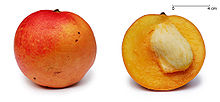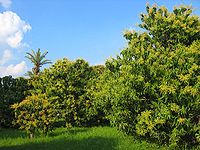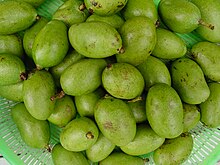Mango is a fruit which is indigenous to the Indian subcontinent,[1] belonging to the genus Mangifera, consisting of numerous species of tropical fruiting trees in the flowering plant family Anacardiaceae. While other Mangifera species (e.g. horse mango, M. foetida) are also grown on a more localized basis, Mangifera indica – the common mango or Indian mango – is the only mango tree commonly cultivated in many tropical and subtropical regions, and its fruit is distributed essentially world-wide.
In several cultures, its fruit and leaves are ritually used as floral decorations at weddings, public celebrations and religious ceremonies.
Contents[hide] |
Etymology
The English word "mango" probably originated from the Tamil word maangai (மாங்காய்), then via Malayalam to Portuguese as manga.[2][3] The word's first recorded attestation in a European language was a text by Ludovico di Varthema in Italian in 1510, as manga; the first recorded occurrences in languages such as French and post-classical Latin appear to be translations from this Italian text. The origin of the "-o" ending in English is unclear.[2]When mangoes were first imported to the American colonies in the 17th century, they had to be pickled due to lack of refrigeration. Other fruits were also pickled and came to be called "mangoes" (especially bell peppers), and by the 18th century, the word "mango" became a verb meaning "to pickle".[4] In Oriya Mango is known as Aamba (ଆମ୍ବ).
Description
Mango trees (Mangifera indica L.) grow 35–40 m (115–130 ft) tall, with a crown radius of 10 m (33 ft). The mango tree is long-lived, as some specimens still fruit after 300 years.[citation needed] In deep soil, the taproot descends to a depth of 6 m (20 ft) and the profuse, wide-spreading feeder roots also send down many anchor roots, which penetrate several feet of soil. The leaves are evergreen, alternate, simple, 15–35 cm (5.9–14 in) long and 6–16 cm (2.4–6.3 in) broad; when the leaves are young they are orange-pink, rapidly changing to a dark glossy red, then dark green as they mature. The flowers are produced in terminal panicles 10–40 cm (3.9–16 in) long; each flower is small and white with five petals 5–10 mm (0.20–0.39 in) long, with a mild sweet odor suggestive of lily of the valley. The fruit takes three to six months to ripen.The ripe fruit is variable in size and color. Cultivars are variously yellow, orange, red or green, and carry a single flat, oblong pit that can be fibrous or hairy on the surface, and which does not separate easily from the pulp. Ripe, unpeeled fruit gives off a distinctive resinous, sweet smell. Inside the pit 1–2 mm (0.039–0.079 in) thick is a thin lining covering a single seed, 4–7 mm (0.16–0.28 in) long. The seed contains the plant embryo.
Cultivation and uses
Mangoes have been cultivated in the Indian subcontinent for thousands of years[5] and reached East Asia between the 5th and 4th centuries BC. By the 10th century AD, cultivation had begun in East Africa.[5] The 14th century Moroccan traveler, Ibn Battuta, reported it at Mogadishu.[6] Cultivation came later to Brazil, the West Indies and Mexico, where an appropriate climate allows its growth.[5]Mango is now cultivated in most frost-free tropical and warmer subtropical climates; nearly half of the world's mangoes are cultivated in India alone.[7][8][9]
Mango is also being grown in Andalusia, Spain (mainly in Málaga province), which is one of the few places in mainland Europe that allows growth of tropical plants and fruit trees.[10] Many of the 1,000 + mango cultivars are easily cultivated using grafted saplings, ranging from the "turpentine mango" (named for its strong taste of turpentine, which according to the Oxford Companion to Food some varieties actually contain) to the huevos de toro ("eggs of the bull", a euphemism for "bull's testicles", referring to the shape and size).
Other cultivators include North, South and Central America, the Caribbean, south, west and central Africa, Australia, China, Pakistan, Bangladesh, and Southeast Asia.
Though India is the largest producer of mangoes, it accounts for less than one percent of the international mango trade, consuming most of its own output.[11]
Dwarf or semi-dwarf varieties serve as ornamental plants and can be grown in containers.
A wide variety of diseases can afflict mangoes; see List of mango diseases.
Potential for contact dermatitis
Mango peel contains urushiol, the chemical in poison ivy and poison sumac that can cause urushiol-induced contact dermatitis in susceptible people.[12] Cross-reactions between mango contact allergens and urushiol have been observed.[13] Those with a history of poison ivy or poison oak contact dermatitis may be most at risk for such an allergic reaction.[14] Urushiol is also present in mango leaves and stems. During mango's primary ripening season, it is the most common source of plant dermatitis in Hawaii.[15]Food
Mango is generally sweet, although the taste and texture of the flesh varies across cultivars, some having a soft, pulpy texture similar to an overripe plum, while the flesh of others is firmer, like a cantaloupe or avocado, or may have a fibrous texture. For consumption of unripe, pickled or cooked fruit, the mango skin may be consumed comfortably, but has potential to cause contact dermatitis (above) of the lips, gingiva or tongue in susceptible people. In ripe fruits which are commonly eaten fresh, the skin may be thicker and bitter tasting, so is typically not eaten.Cuisine
Mangoes are widely used in cuisine. Sour, unripe mangoes are used in chutneys, athanu, pickles, or side dishes, or may be eaten raw with salt, chili, or soy sauce. A cooling summer drink called panna or panha comes from mangoes.Ripe mangoes are typically eaten fresh; however, they can have many other culinary uses. Mango Lassi, a popular drink made throughout South Asia[citation needed], is created by mixing ripe mangoes or mango pulp with yogurt and sugar. Ripe mangoes are also used to make curries. Aamras is a popular pulp/thick juice made of mangoes with sugar or milk, and is consumed with bread.
Mangoes are used in preserves like moramba, amchur (dried and powdered unripe mango) and pickles, including a spicy mustard-oil pickle. Ripe mangoes are often cut into thin layers, desiccated, folded, and then cut. These bars are similar to dried guava fruit bars available in some countries. The fruit is also added to cereal products like muesli and oat granola.
Unripe mango may be eaten with bagoong (especially in the Philippines), fish sauce or with dash of salt. Dried strips of sweet, ripe mango (sometimes combined with seedless tamarind to form mangorind) are also popular. Mangoes may be used to make juices, mango nectar, and as a flavoring and major ingredient in ice cream and sorbetes.
Mango is used to make juices, smoothies, ice cream, fruit bars, raspados, aguas frescas, pies and sweet chili sauce, or mixed with chamoy, a sweet and spicy chili paste. It is popular on a stick dipped in hot chili powder and salt or also as a main ingredient in fresh fruit combinations. In Central America, mango is either eaten green mixed with salt, vinegar, black pepper and hot sauce, or ripe in various forms. Toasted and ground pumpkin seed (called pepita) with lime and salt are the norm when eating green mangoes. Some people also add soy sauce or chili sauce.
Pieces of mango can be mashed and used as a topping on ice cream or blended with milk and ice as milkshakes. Sweet glutinous rice is flavored with coconut, then served with sliced mango as a dessert. In other parts of Southeast Asia, mangoes are pickled with fish sauce and rice vinegar. Green mangoes can be used in mango salad with fish sauce and dried shrimp. Mango with condensed milk may be used as a topping for shaved ice.
Nutrients and phytochemicals
| Nutritional value per 100 g (3.5 oz) | |
|---|---|
| Energy | 272 kJ (65 kcal) |
| Carbohydrates | 17.00 g |
| Sugars | 14.8 g |
| Dietary fiber | 1.8 g |
| Fat | 0.27 g |
| Protein | 0.51 g |
| Vitamin A equiv. | 38 μg (4%) |
| - beta-carotene | 445 μg (4%) |
| Thiamine (Vit. B1) | 0.058 mg (4%) |
| Riboflavin (Vit. B2) | 0.057 mg (4%) |
| Niacin (Vit. B3) | 0.584 mg (4%) |
| Pantothenic acid (B5) | 0.160 mg (3%) |
| Vitamin B6 | 0.134 mg (10%) |
| Folate (Vit. B9) | 14 μg (4%) |
| Vitamin C | 27.7 mg (46%) |
| Calcium | 10 mg (1%) |
| Iron | 0.13 mg (1%) |
| Magnesium | 9 mg (2%) |
| Phosphorus | 11 mg (2%) |
| Potassium | 156 mg (3%) |
| Zinc | 0.04 mg (0%) |
| Percentages are relative to US recommendations for adults. Source: USDA Nutrient database | |
Mango contains essential vitamins and dietary minerals. The antioxidant vitamins A, C and E compose 25%, 76% and 9% of the Dietary Reference Intake (DRI) in a 165 grams (5.8 oz) serving. Vitamin B6 (pyridoxine, 11% DRI), vitamin K (9% DRI), other B vitamins and essential nutrients, such as potassium, copper and 17 amino acids are at good levels. Mango peel and pulp contain other phytonutrients, such as the pigment antioxidants – carotenoids and polyphenols – and omega-3 and -6 polyunsaturated fatty acids.<>
Mango peel contains pigments that may have antioxidant properties,[16][18] including carotenoids, such as the provitamin A compound, beta-carotene, lutein and alpha-carotene,[19] polyphenols[20][21] such as quercetin, kaempferol, gallic acid, caffeic acid, catechins, tannins, and the unique mango xanthonoid, mangiferin,[22] any of which may counteract free radicals in various disease processes as revealed in preliminary research.[23][24] Phytochemical and nutrient content appears to vary across mango species.[25] Up to 25 different carotenoids have been isolated from mango pulp, the densest of which was beta-carotene, which accounts for the yellow-orange pigmentation of most mango species.[26] Peel and leaves also have significant polyphenol content, including xanthonoids, mangiferin and gallic acid.[27]
The mango triterpene, lupeol,[28] is an effective inhibitor in laboratory models of prostate and skin cancers.[29][30][31] An extract of mango branch bark called Vimang, isolated by Cuban scientists, contains numerous polyphenols with antioxidant properties in vitro[32] and on blood parameters of elderly humans.[33]
The pigment euxanthin, known as Indian yellow, is often thought to be produced from the urine of cattle fed mango leaves; the practice is described as having been outlawed in 1908 due to malnutrition of the cows and possible urushiol poisoning.[34] This supposed origin of euxanthin appears to rely on a single, anecdotal source, and Indian legal records do not outlaw such a practice.[35]
Cultural significance
The mango is the national fruit of India,[36] Pakistan, and the Philippines.[37] The mango tree is the national tree of Bangladesh.[38]
In Hinduism, the perfectly ripe mango is often held by Lord Ganesha as a symbol of attainment, regarding the devotees potential perfection. Mango blossoms are also used in the worship of the goddess Saraswati.
Mango leaves are used to decorate archways and doors in Indian houses and during weddings and celebrations like Ganesh Chaturthi. Mango motifs and paisleys are widely used in different Indian embroidery styles, and are found in Kashmiri shawls, Kanchipuram silk sarees, etc. Paisleys are also common to Iranian art, because of its pre-Islamic Zoroastrian past.
In Australia, where mangoes are considered to be a symbol of summer, the first tray of mangoes of the season is traditionally sold at an auction for charity.[39]
Production and consumption
Mangoes account for approximately half of all tropical fruits produced worldwide. The Food and Agriculture Organization of the United Nations estimates worldwide production at more than 33,000,000 tonnes (36,000,000 short tons) in 2007 (table below). The aggregate production of the top 10 countries is responsible for roughly 80% of production.Alphonso, Benishaan or Benisha (Banganapalli in Telugu and Tamil) and Kesar mango varieties are considered among the best mangoes in India's southern states, while Dussehri and Langda varieties are most popular in the northern states.
Generally, ripe mangoes have an orange-yellow or reddish peel and are juicy for eating, while exported fruit are often picked while underripe with green peels. Although producing ethylene while ripening, unripened exported mangoes do not have the same juiciness or flavor as fresh fruit.
Like other drupaceous fruits, mangoes come in both freestone and clingstone varieties.
| Country | Production in tons | |||
|---|---|---|---|---|
| World total | ||||
| Source | ||||
Cultivars
Main article: List of mango cultivars

Alphonso mangoes (local name: Hapoos) are grown mainly in Devgad, Sindhudurg and Ratnagiri districts of Maharashtra, India, and favored there, and are now popular in the United States.[40][41]
Cultivars that excel in one climate may fail elsewhere. For example, Indian cultivars such as Julie, a prolific cultivar in Jamaica, require annual fungicide treatment to escape a lethal fungal disease known as anthracnose in Florida. Asian mangoes are resistant to anthracnose.
The current world market is dominated by the cultivar Tommy Atkins, a seedling of Haden that first fruited in 1940 in southern Florida, US. It was initially rejected commercially by Florida researchers.[42] For example, 80% of mangoes in UK supermarkets are Tommy Atkins. Despite its fibrous flesh and fair taste, growers worldwide have embraced the cultivar for its exceptional productivity and disease resistance, shelf-life, transportability and size and appealing color. Tommy Atkins is predominant in the US as well, although other cultivars, such Kent, Keitt, the Haitian-grown Madame Francis and the Mexican grown Champagne are widely available.
In urban areas of southern Florida, small gardens have fueled the desire for dwarf mango trees. The Fairchild Tropical Botanic Garden has promoted "condo mangoes," such as Fairchild, which produces at a height below 2–2.5 m (6.6–8.2 ft).[citation needed]
Condo mango is a term that became popular some years ago in Florida, US, and the word "condo" is derived from the word condominium because a condo mango tree, being dwarfed and small in size, was suitable for container growing in condominiums. Essentially, "condo" means a smaller variety of tree that is dwarf or semidwarf in nature, e.g. Ice Cream, or grafted to achieve a dwarfing characteristic, that can be maintained to a certain size with careful foliage pruning and root pruning if necessary. While condo has been generally associated with mango trees, it can be applied to any fruit tree that is a natural dwarf or has been dwarfed similar to the bonsai technique. As such, the words "condo" and "dwarf" are interchangeable.
There is an Australian variety of mango known as R2E2, a name based on the original plant's orchard row location. This variety produces large (up to 1 kilograms (2 lb)) yellow-red fruit that attracts a premium price in the Australian market.
Gallery
Banganpalli mangoes sold at Guntur, India | A mango stand in Merritt Island, Florida | A nearly-ripened purple mango, Israel |






















No comments:
Post a Comment